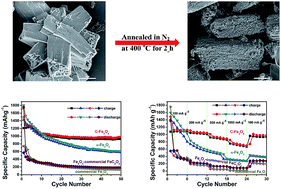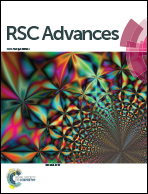Large-scale fabrication of porous carbon-decorated iron oxide microcuboids from Fe–MOF as high-performance anode materials for lithium-ion batteries
Abstract
A facile, cost-effective and environmentally friendly route has been developed to synthesise porous carbon-decorated iron oxides on a large scale via annealing iron metal–organic framework (MOF) precursors. The as-prepared C–Fe3O4 particles exhibit microcuboid-like morphologies that are actually composed of ultrafine nanoparticles and show a greatly enhanced lithium storage performance with high specific capacity, excellent cycling stability and good rate capability. The C–Fe3O4 electrodes demonstrate a high reversible capacity of 975 mA h g−1 after 50 cycles at a current density of 100 mA g−1 and a remarkable rate performance, with capacities of 1124, 1042, 886 and 695 mA h g−1 at current densities of 100, 200, 500 and 1000 mA g−1, respectively. The satisfactory electrochemical performance was attributed to the hierarchical architecture, which benefitted from the synergistic effects of the high conductivity of the carbon matrix, the cuboid-like secondary particles on the microscale, and the ultrafine primary nanoparticles on the nanoscale. This low-cost and simple method provides the possibility to prepare anode materials on a large scale and hence may have great potential applications in energy storage and conversion.


 Please wait while we load your content...
Please wait while we load your content...